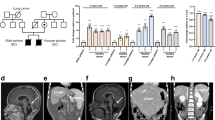Abstract
Background
Dyskeratosis congenita (DC) is a rare inherited bone marrow failure syndrome with high clinical heterogeneity. Various mutations have been reported in DC patients, affecting genes that code for components of H/ACA ribonucleoproteins, proteins of the telomerase complex and components of the shelterin complex.
Objectives
We aim to clarify the role of ribosome biogenesis failure in senescence induction in X-DC since some studies in animal models have reported a decrease in ribosome biogenesis as a major role in the disease.
Methods
Dyskerin was depleted in normal human fibroblasts by expressing two DKC1 shRNAs. Common changes in gene expression profile between these dyskerin-depleted cells and X-DC fibroblasts were analyzed.
Results
Dyskerin depletion induced early activation of the p53 pathway probably secondary to ribosome biogenesis failure. However, the p53 pathway in the fibroblasts from X-DC patients was activated only after an equivalent number of passes to AD-DC fibroblasts, in which telomere attrition in each division rendered shorter telomeres than control fibroblasts. Indeed, no induction of DNA damage was observed in dyskerin-depleted fibroblasts in contrast to X-DC or AD-DC fibroblasts suggesting that DNA damage induced by telomere attrition is responsible for p53 activation in X-DC and AD-DC fibroblasts. Moreover, p53 depletion in senescent DC fibroblasts rescued their proliferative capacity and reverted the morphological changes produced after prolonged culture.
Conclusions
Our data indicate that ribosome biogenesis do not seem to play an important role in dyskeratosis congenita, conversely increasing DNA damage and activation of p53 pathway triggered by telomere shortening is the main activator of cell senescence.






Similar content being viewed by others
References
Bessler M, Wilson DB, Mason PJ. Dyskeratosis congenita. FEBS Lett. 2010;584(17):3831–8.
Savage SA, Blanche P. Alter dyskeratosis congenita. Hematol Oncol Clin North Am. 2009;23(2):215–31. doi:10.1016/j.hoc.2009.01.003.
Dokal I, Vulliamy T, Mason P, Bessler M. Clinical utility gene card for: dyskeratosis congenita. Eur J Hum Genet. 2011;19:231–5. doi:10.1038/ejhg.2011.90.
Vulliamy T, Marrone A, Szydlo R, Walne A, Mason PJ, Dokal I. Disease anticipation is associated with progressive telomere shortening in families with dyskeratosis congenita due to mutations in TERC. Nat Genet. 2004;36(5):447–9.
Yamaguchi H, Calado RT, Ly H, Kajigaya S, Baerlocher GM, Chanock SJ, et al. Mutations in TERT, the gene for telomerase reverse transcriptase, in aplastic anemia. N Engl J Med. 2005;352(14):1413–24.
Parry EM, Alder JK, Lee SS, Phillips JA, Loyd JE, Duggal P, et al. Decreased dyskerin levels as a mechanism of telomere shortening in X-linked dyskeratosis congenita. J Med Genet. 2011;48(5):327–33.
Ge J, Rudnick DA, He J, Crimmins DL, Ladenson JH, Bessler M, et al. Dyskerin ablation in mouse liver inhibits rRNA processing and cell division. Mol Cell Biol. 2010;30(2):413–22.
Ruggero D, Grisendi S, Piazza F, Rego E, Mari F, Rao PH, et al. Dyskeratosis congenita and cancer in mice deficient in ribosomal RNA modification. Science. 2003;299(5604):259–62.
Pereboom TC, van Weele LJ, Bondt A, MacInnes AW. A zebrafish model of dyskeratosis congenita reveals hematopoietic stem cell formation failure resulting from ribosomal protein-mediated p53 stabilization. Blood. 2011;118(20):5458–65.
Zhang Y, Morimoto K, Danilova N, Zhang B, Lin S. Zebrafish models for dyskeratosis congenita reveal critical roles of p53 activation contributing to hematopoietic defects through RNA processing. PLoS One. 2012;7(1):e30188.
Panic L, Montagne J, Cokaric M, Volarevic S. S6-Haploinsufficiency activates the p53 tumor suppressor. Cell Cycle. 2007;6(1):20–4.
Carrillo J, Martínez P, Solera J, Moratilla C, González A, Manguán-García C, et al. High resolution melting analysis for the identification of novel mutations in DKC1 and TERT genes in patients with dyskeratosis congenita. Blood Cells Mol Dis. 2012;49(3–4):140–6.
Nagasawa H, Little JB. Suppression of cytotoxic effect of mitomycin-C by superoxide dismutase in Fanconi’s anemia and dyskeratosis congenita fibroblasts. Carcinogenesis. 1983;4:795–9.
Heiss NS, Knight SW, Vulliamy TJ, Klauck SM, Wiemann S, Mason PJ, et al. X-linked dyskeratosis congenita is caused by mutations in a highly conserved gene with putative nucleolar functions. Nat Genet. 1998;19(1):32–8.
Wong JMY, Kyasa MJ, Hutchins L, Collins K. Telomerase RNA deficiency in peripheral blood mononuclear cells in X-linked dyskeratosis congenita. Hum Genet. 2004;115:448–55.
d’Adda di Fagagna F, Reaper PM, Clay-Farrace L, Fiegler H, Carr P, Von Zglinicki T, et al. A DNA damage checkpoint response in telomere-initiated senescence. Nature. 2003;426:194–8.
Chan SS, Chang S. Defending the end zone: studying the players involved in protecting chromosome ends. FEBS Lett. 2010;584(17):3773–8.
d’Adda di Fagagna F, Teo SH, Jackson SP. Functional links between telomeres and proteins of the DNA-damage response. Genes Dev. 2004;18:1781–99.
Vulliamy T, Beswick R, Kirwan M, Marrone A, Digweed M, Walne A, et al. Mutations in the telomerase component NHP2 cause the premature ageing syndrome dyskeratosis congenita. Proc Natl Acad Sci. 2008;105(23):8073–8.
Walne AJ, Vulliamy T, Marrone A, Beswick R, Kirwan M, Masunari Y, et al. Genetic heterogeneity in autosomal recessive dyskeratosis congenita with one subtype due to mutations in the telomerase-associated protein NOP10. Hum Mol Genet. 2007;16(13):1619–29.
Jullien L, Mestre M, Roux P, Gire V. Eroded human telomeres are more prone to remain uncapped and to trigger a G2 checkpoint response. Nucleic Acids Res. 2013;41(2):900–11. doi:10.1093/nar/gks1121 (Epub 2012 Nov 27).
Machado-Pinilla R, Sanchez-Perez I, Ramon Murguia J, Sastre L, Perona R. A dyskerin motif reactivates telomerase activity in X-linked dyskeratosis congenita and in telomerase-deficient human cells. Blood. 2008;111(5):2606–14.
Westin ER, Aykin-Burns N, Buckingham EM, Spitz DR, Goldman FD, Klingelhutz AJ. The p53/p21WAF/CIP pathway mediates oxidative stress and senescence in dyskeratosis congenita cells with telomerase insufficiency. Antioxid Redox Signal. 2011;14(6):985–97.
Acknowledgments
This work was supported by grants: 11/00949 from FIS and Fundación Ramón Areces. C. Manguán-García and J. Carrillo were supported by CIBER de Enfermedades Raras. We gratefully acknowledge to Leandro Sastre for helpful discussions and critical reading of the manuscript.
Author information
Authors and Affiliations
Corresponding author
Rights and permissions
About this article
Cite this article
Carrillo, J., González, A., Manguán-García, C. et al. p53 pathway activation by telomere attrition in X-DC primary fibroblasts occurs in the absence of ribosome biogenesis failure and as a consequence of DNA damage. Clin Transl Oncol 16, 529–538 (2014). https://doi.org/10.1007/s12094-013-1112-3
Received:
Accepted:
Published:
Issue Date:
DOI: https://doi.org/10.1007/s12094-013-1112-3




